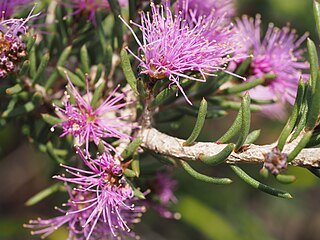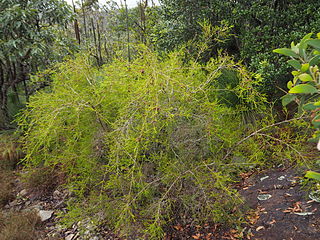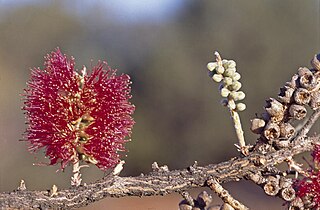
Melaleuca pityoides, commonly known as alpine bottlebrush, is a plant in the myrtle family, Myrtaceae and is endemic to the higher areas of south eastern Australia.. It is a shrub, often occurring in dense thickets, with hard bark, silvery-grey new growth, almost cylindrical leaves and spikes of flowers that are usually a shade of yellow.

Melaleuca orophila, commonly known as needle bottlebrush or Flinders Ranges bottlebrush, is a plant in the myrtle family, Myrtaceae and is endemic to the eastern part of South Australia.. It is a medium-sized shrub with sharp-pointed, needle-like leaves and bright red bottlebrush flower spikes.
Melaleuca penicula is a plant in the myrtle family, Myrtaceae and is endemic to the south of Western Australia. It is a rare species only known from the Fitzgerald River National Park and resembles Melaleuca eximia with its spikes of red flowers but its leaves and stamen bundles are different.

Melaleuca linguiformis is a plant in the myrtle family, Myrtaceae and is endemic to the south of Western Australia. It is a shrub with hairy new growth, small leaves and heads of white flowers similar to Melaleuca teuthidoides shorter sepals and more stamens in each flower.

Melaleuca longistaminea is a plant in the myrtle family Myrtaceae, and is endemic to the south-west of Western Australia. It is a shrub with small, prickly, heart-shaped leaves and heads of yellow to green flowers on the sides of the stems in winter and spring. It is similar to Melaleuca spectabilis which was formerly included in this species but has smaller flowerheads and narrower leaves.

Melaleuca monantha is a plant in the myrtle family, Myrtaceae and is endemic to an area in Queensland, Australia. It is a shrub, similar to Melaleuca minutifolia with very small leaves but the leaves lack oil glands and its flowers occur singly, rather than in pairs. It is also similar to Melaleuca sylvana but is usually multi-stemmed and has a more dense crown than that species.

Melaleuca nematophylla, commonly known as wiry honey-myrtle is a plant in the myrtle family, Myrtaceae and is endemic to the south-west of Western Australia. It is one of the showiest melaleucas when in flower in early spring, is easily grown and has unusual needle-like foliage. As a result, it is relatively common in cultivation in temperate parts of Australia.

Melaleuca papillosa is a plant in the myrtle family, Myrtaceae and is endemic to the south-west of Western Australia. It is one of the smallest species of Melaleuca, distinguished by its narrow, usually hairy, pimply leaves, small heads of pink to purple flowers surrounded by silky hairs and scattered rather than clustered fruits.
Melaleuca sylvana is a plant in the myrtle family Myrtaceae and is endemic to a small area near Ravenshoe in Queensland, Australia. It is a newly described (2004) species similar to Melaleuca monantha with its tiny leaves and heads of white flowers but is a larger, single stemmed shrub or tree with a less dense crown.

Melaleuca uxorum is a plant in the myrtle family Myrtaceae and is endemic to the northern Herberton Range in far north Queensland. It is a newly described (2004) species similar to Melaleuca sylvana and Melaleuca monantha, also from far north Queensland.
Melaleuca villosisepala is a shrub in the myrtle family Myrtaceae and is endemic to the south-west of Western Australia. It is a shrub with narrow leaves, heads of pink to mauve flowers that fade to white and is similar to Melaleuca wonganensis except that its heads of flowers are smaller and pinkish rather than deep purple.

Melaleuca wonganensis is an erect shrub in the myrtle family Myrtaceae and is endemic to the south-west of Western Australia. It is a shrub with narrow leaves and purple to deep mauve flowers and is restricted in its distribution to the Wongan Hills district.

Melaleuca wilsonii, commonly known as Wilson's honey-myrtle or violet honey-myrtle, is a plant in the myrtle family, Myrtaceae, native to parts of South Australia and Victoria. It is a shrub with narrow, pointed leaves and heads of purplish-pink flowers on the sides of the branches. It is adaptable to a wide range of soils, frost hardy and often cultivated.

Melaleuca apostiba is a shrub in the myrtle family, Myrtaceae and is endemic to the south-west of Western Australia. It was first described in 1990 by Kirsten Cowley and remains a poorly known species. It resembles Melaleuca lateritia except for its hairy leaves and flower structures as well as its leaf shape and size.

Melaleuca undulata, commonly known as hidden honey-myrtle is a shrub in the myrtle family Myrtaceae and is endemic to the south of Western Australia. It is a spreading, moderately dense, perennial, woody shrub with creamy-white flowers in small clusters.

Melaleuca bisulcata is a plant in the myrtle family, Myrtaceae and is endemic to the a relatively small area on the west coast of Western Australia. It is difficult to distinguish this species from Melaleuca psammophila except on differences in the shape of the calyx lobes.

Melaleuca dichroma is a shrub in the myrtle family, Myrtaceae and is endemic to the south-west of Western Australia. It is unusual for its genus in that its flowers are yellow or creamy-white but age to a pinkish-red.

Melaleuca glaberrima is a plant in the myrtle family, Myrtaceae and is endemic to the south-west of Western Australia. It is a dense, spreading shrub with needle shaped, but not sharp leaves and profuse pink or mauve flowers.

Melaleuca polandii, commonly known as gold-tipped bottlebrush, is a plant in the myrtle family, Myrtaceae and is endemic a small area in far northern Queensland in Australia. It is a dense shrub with bronze-coloured, hairy new growth and spikes of red flowers tipped with yellow.

Melaleuca wimmerensis, commonly known as the Wimmera bottlebrush, is a plant in the myrtle family, Myrtaceae and is endemic to the state of Victoria in Australia.. It is a recently (2008) discovered shrub, often with many stems arising from a lignotuber and is similar to Melaleuca paludicola but has pink or mauve flowers tipped with yellow anthers over a short period between October and early December.
















